Kingdomino Origins Review | 3-way Dominoes
Does Kingdomino Origins live up to the pedigree of its predecessor and does it add anything new to the table? Lets find out in this review!
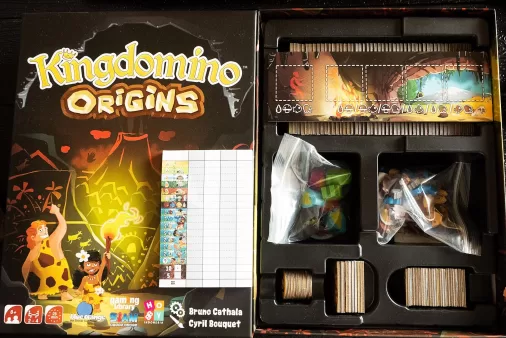
Does the game live up to the pedigree of its predecessor and does it add anything new to the table? Let’s find out in our review for Kingdomino Origins!
Almost every household has played dominoes and it’s a staple family game, and it is so refreshing to see old classics reimagined and reinvented by modern game designers. Kingdomino Origins, by premiere game designer Bruno Cathala, is the fourth in a series of Kindomino games. The original Kingdomino won the 2017 Spiel de Jahres, arguably the most coveted award in all of boardgaming.
Whats in the Box
In Kingdomino Origins, you play a prehistoric tribal chief, helping expand your territory and gathering resources needed for your paleothic people to flourish, and in later modes you recruit specialist Cavemen. It plays from 2 to 4 players and has a game time of roughly 20-30 minutes. The box suggests the game is playable by ages 8 and up.
Kingdomino Origins comes in a mid sized box that’s great for taking around. Contents include 4 sets of starting tiles, 3d huts, 2 wooden tribe chiefs in 4 different colors; each set to be divided among the players. It also comes with 48 domino terrain tiles, a cave board, caveman and totem tiles, 10 fire tokens, 49 wooden resources and a scorepad. Components are neatly arranged in a box insert that makes sorting and setup a breeze.
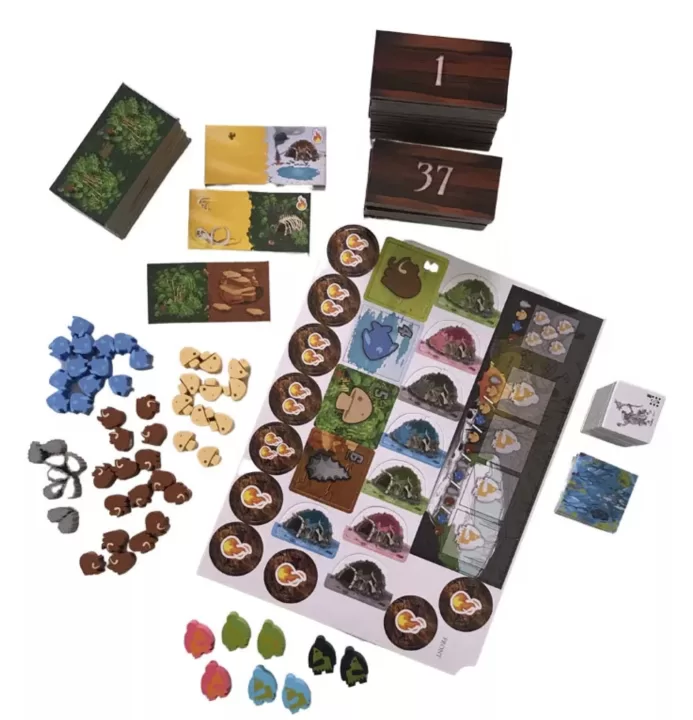
components image care of Boardgame Geek
The domino, totem and caveman specialist tiles are thick and have amusing, brightly colored, cartoony art. The wooden components are equally colorful and quite cute in design. Thus overall quality of components is excellent especially for a game at its price point. The art is also appealing; it’s cute enough to entice children to play but not too childish that adults would find it annoying.
Because of regional partnerships, the rulebook contains rules in many languages, and it is a hoot reading rules in our native Filipino. Gaming Library is the Philippine partner, as evidenced by their logo on the box. Aside from region specific rulesets, having a regional partner also lowers distribution costs and thus these types of games are often sold at cheaper prices. I hope to see more regional partnerships in the Philippines as this may help offset increasing prices and make boardgaming more appealing to the typical Filipino.
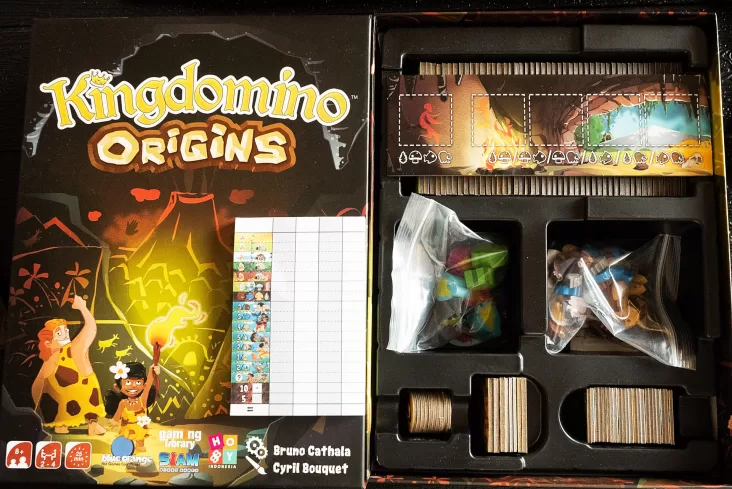
components neatly organized thanks to inserts
Prehistoric Tile Placement
Just like its predecessors, Kingdomino Origins is a tile placement game. Your goal is to build your prehistoric encampment by connecting dominoes and building a 5×5 grid. Each player builds his own separate tribal territory and points are scored at the end of the game depending on which mode you play.
Players start with a tribal chief, a hut of the chief’s color and a starting tile. The dominoes are then shuffled and placed in a pile with the numbered sides facing up. The first 4 dominoes are placed in a vertical row, with the lowest numbered tile on top and arranged in ascending order downwards. The dominoes are then flipped over. The wooden tribal chiefs are then shuffled in hand and one is drawn. The player of that color then chooses what domino he wants and places his tribal chief there. All tribal chiefs are drawn and are placed in the dominoes of choice by their players. When all chiefs have been placed, a new setup of dominoes are placed next to the original line and are arranged by ascending number and are then flipped, just as before.
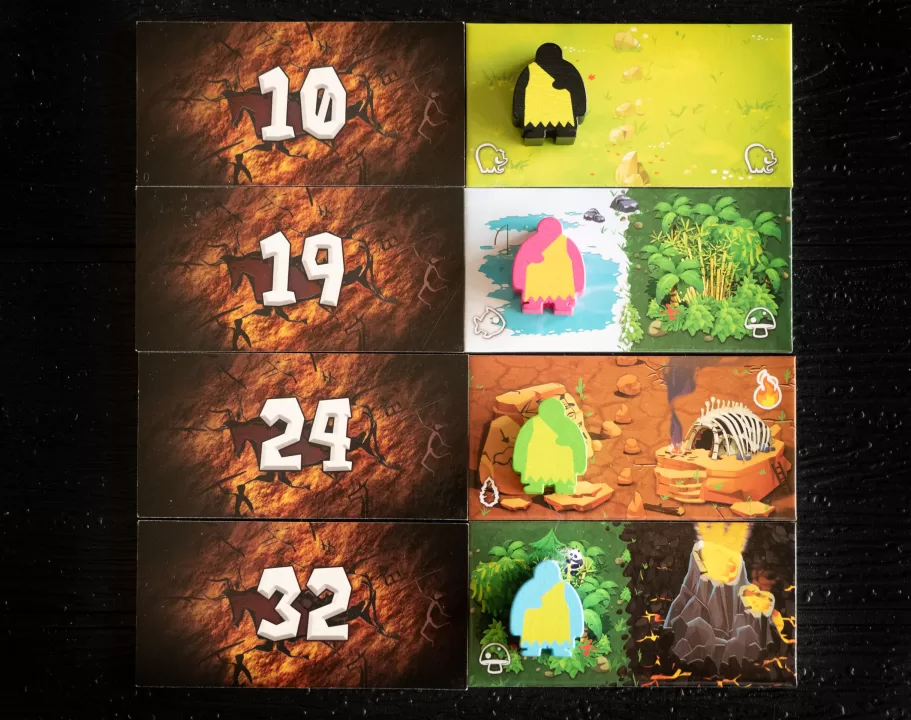
players choosing dominoes
Player turns are determined by the position of the tribal chiefs in the line of dominoes. On a player’s turn, they do two things. First, the player takes his chosen domino and attaches it to his territory. The player has to connect the domino by matching it to at least 1 similar terrain tile horizontally or vertically, just like the game of dominoes. The starting tile with the 3d hut is considered wild, so you can attach any piece to this. After attaching your domino, the player then selects from the next row of tiles his chosen domino and places his tribal chief there. Play continues in this fashion until all players have laid out their 5×5 grid (7×7 for 2 player). It is possible that the player may not place all dominoes because there is no legal terrain to connect to or there isn’t enough space to place the domino. At the end, score is tallied by adding connected terrain that form a region. How a region actually scores depends on the game mode the player chooses and a scoring pad is provided to help tally scores.
Mode Mania
The first mode is called Discovery Mode. In this mode, volcanic tiles contain craters that spew lava and send flames flying. Tribesmen gather these flames to make campfires. Volcanic tiles can have 1, 2 or 3 craters and they will spew that many fireballs. When a player places a domino with a volcano, he takes the fire token with fireballs that matches the volcano craters. He then places the fire token any number of spaces, as indicated by the distance at the back of the token, to land on another tile that is neither a volcano nor has fire symbols or tokens already there. At the end of the game, each region is scored by the number of tiles multiplied by the number of fire symbols/tokens in that region.
The next mode is Totem Mode which includes Discovery Mode plus resources. When flipping over dominoes (after arranging them by number), players place wooden resources as indicated on the lower left or right of the terrain tile. Take the 4 totem tiles from the box as they are used in this mode. Players place dominoes into their territory together with the wooden resources. If they have the majority of any resource (compared to other players), they take the corresponding totem tile. If a player gets more of the same resources in their turn, the totem transfers to them. Scoring is similar to Discovery Mode, but players also get 1 point for every wooden resource plus the score on each totem tile they own.
The final mode is Tribe Mode . Again, it incorporates the elements of the simpler modes. This mode adds specialist cavemen tiles that the player can add to their territory. Players spend any 2 different resources to recruit a caveman from a tableau and place them in his/her region. Each caveman scores differently depending on their surrounding tiles and resources. Alternatively, a player can spend 4 different resources to recruit a caveman of his choice from a facedown pile. Points scored per caveman specialist are then added to the player’s total at the end of the game.
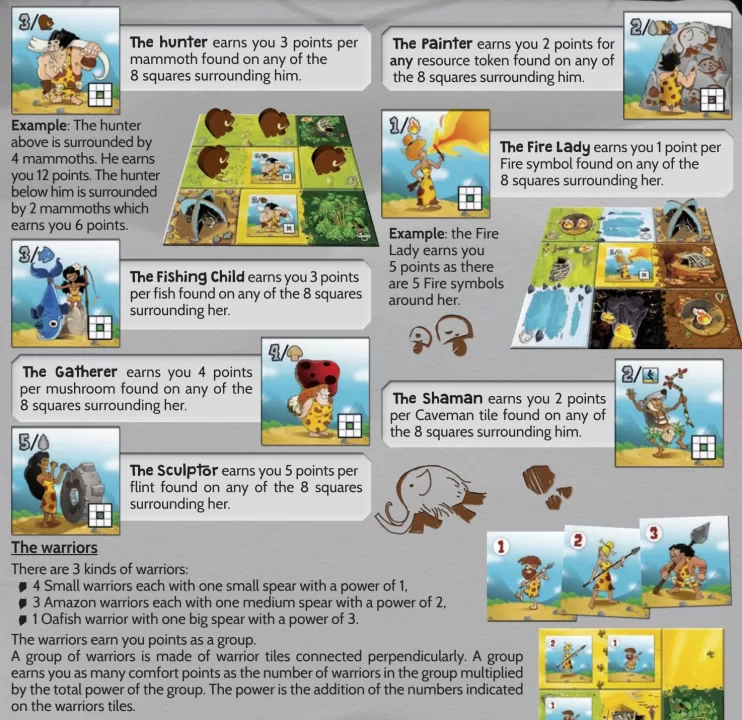
cavemen and how they score
A more comprehensive look at game rules can be found by downloading the official online rules pdf from the publisher’s site.
Thinky Family Fun
The game design is elegant and embodies the core values of what eurogames originally stand for – a thinky, family friendly, non confrontational game that doesn’t overstay its welcome. The art and relative simplicity of mechanics belie a game that encourages you to plan and think. One of the most interesting aspects of the game is tile selection. Tiles are sorted by number, so if you choose the higher number (a domino towards the bottom of the row), which corresponds to potentially better scoring tiles, you will most definitely get to choose last during the next round. Not only does this mechanism give the player some interesting decision options but it also provides the game with a self balancing mechanism, wherein players who chose powerful tiles this round will likely have last choice for the powerful tiles next round.
Although it shares the Kindgdomino name with its predecessors, Kingdomino Origins is a stand alone game that requires no prior knowledge of the original game. Having played the original, Origins definitely has more to offer with its 3 game modes. Discovery Mode will appeal to first time players and younger gamers, while Totem Mode and Tribe Mode will be more to the liking of casual and veteran gamers respectively. In that sense, it is a game that can adapt to what the players want – a design feature that many games lack.
The way Tribe Mode adds complexity and strategy to the game is interesting. Mechanically, the game rules of this mode are easy to implement, but these additions change the game. In Tribe Mode you are not only concerned with building contiguous regions but now have to contend with what resources to spend in order to place Cavemen in the most desirable way so that they are surrounded by resources that gives bonus points. In this mode you are not as limited by tile selection as you can get many points from optimized placement of Cavemen.
Veteran players may feel that Totem Mode doesn’t add much to overall strategy, and they are correct. But the game mode is still important because it acts like a bridge from the simpler to the more complex modes for more casual players.
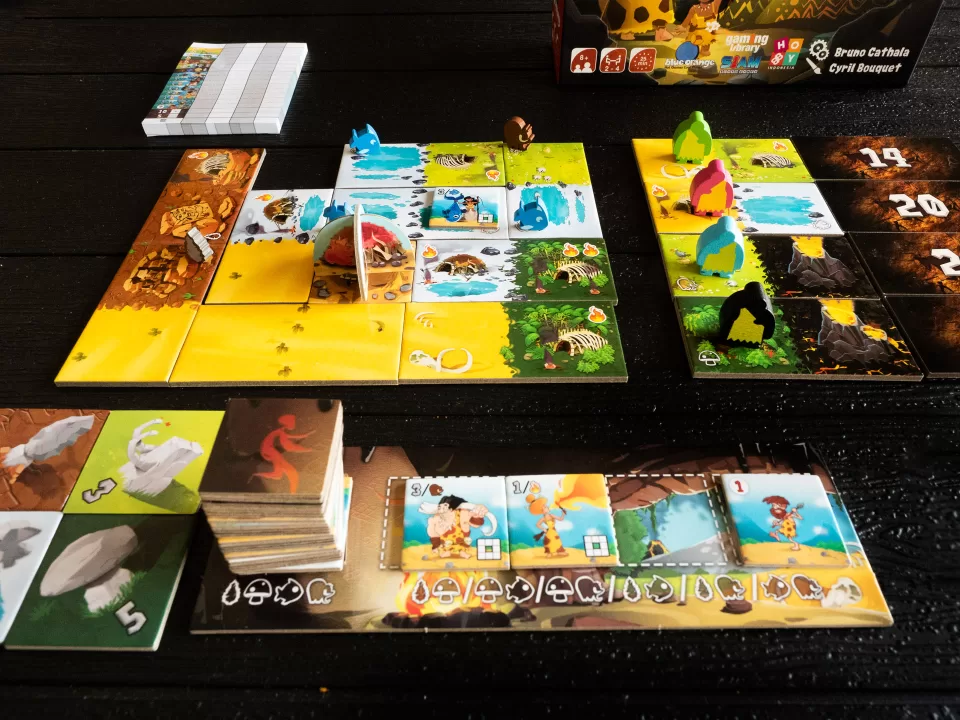
Tribal Mode is a good filler game for veterans
Game length is also ideal. No matter what game mode you choose, you will be thinking and strategizing for 30 minutes or so. Any longer (or more complex) and the game would likely be an optimization slog and overstay its welcome. It also gives opportunity for the non winning players to try again and seek ‘revenge’, allowing multiple group plays in a single session. The short game length also makes it accessible to children; and together with its portability, will make a great travel game or a game that can be played while waiting for your dinner to be served. Some enthusiast boardgamers may overlook this title simply on the basis of its art and relatively simple rules, which is a mistake. The advanced game mode provides ample amount of cerebral calisthenics for a filler game for game veterans.
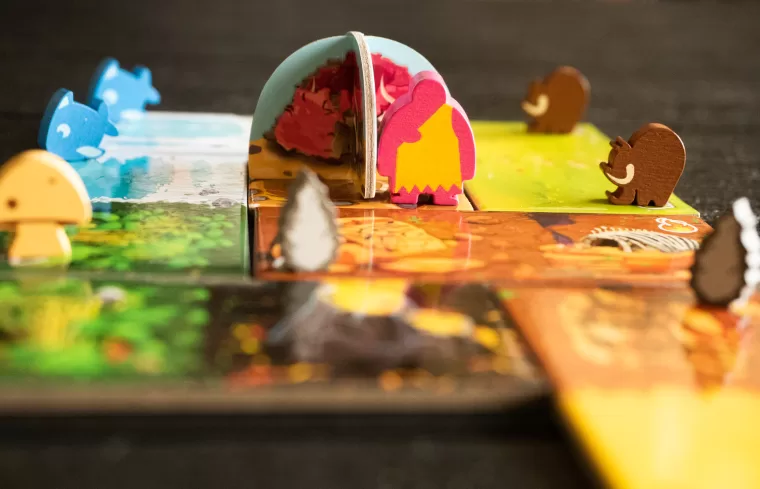
we didn’t start the fire…
If you haven’t played the original Kingdomino, get Kingdomino Origins. Whether you’re a seasoned gamer looking for a thinky filler or a parent looking for a game your family and friends can play, this game won’t disappoint. Be introduced to the genius of Bruno Cathala. Origins is a perfect example of why he is such a celebrated, multi awarded game designer, and it may just entice you to check his other classics such as Five Tribes, 7 Wonders Duel and Cyclades. If you are a game designer, check out this game. I believe there is much one can learn here from mechanics, to presentation, to multi game modes, to resurrecting classic designs with a modern twist. And if you have the older Kindgomino games, as good as they are, I believe this game is far superior. You wont need two in your collection, but in my opinion, Kingdomino Origins is such a worthy upgrade, that you are better off selling your old game and sticking with this one.
Review Score: 9/10

